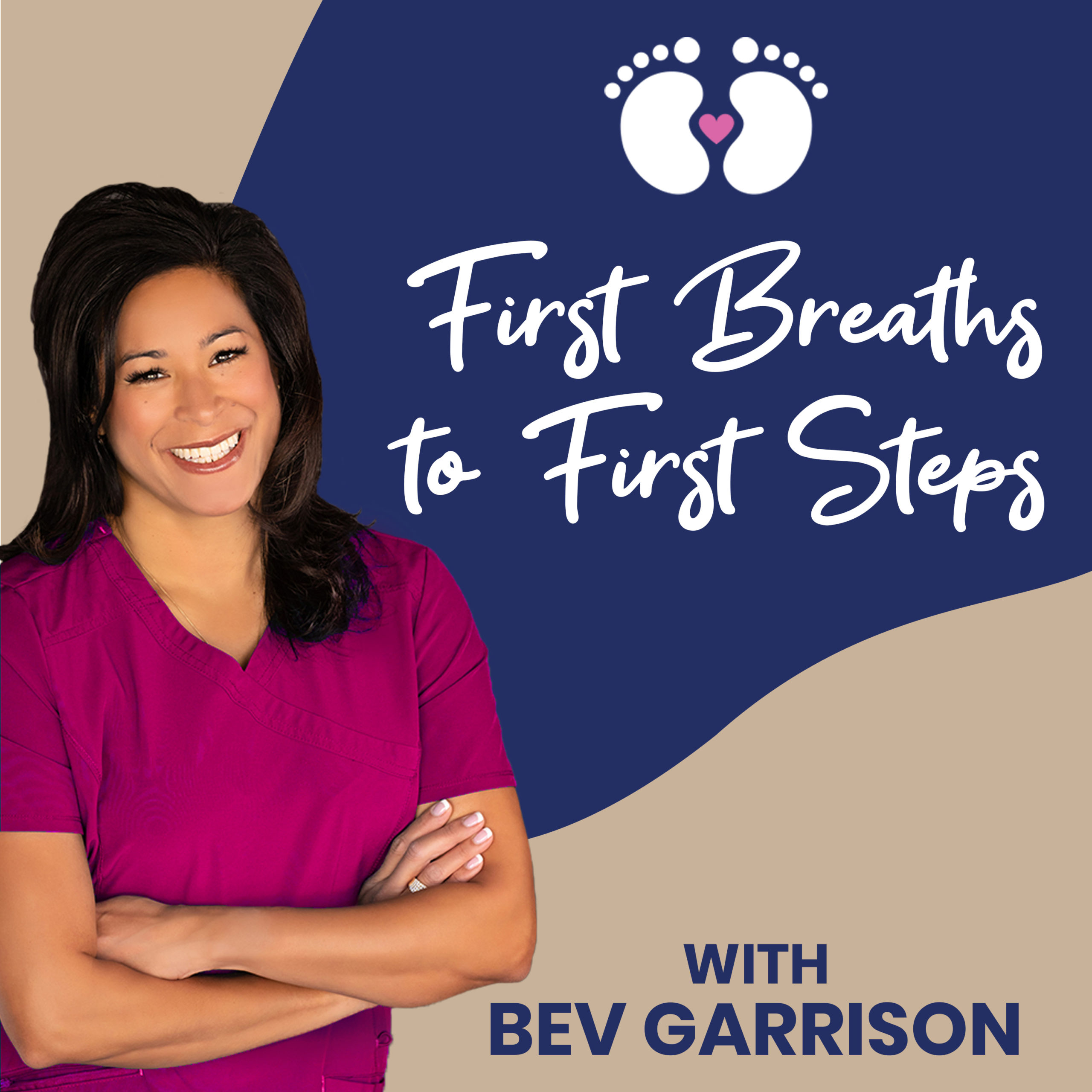Discussion of tongue ties, inverted nipples and health history concerning for both newborns and Moms when breastfeeding.

Episode Transcript
All right. Welcome back today. I have joining me, Jodi Heiser, and she is a nursing expert in breastfeeding, as well as a lactation consultant. We are so lucky to have Jody today. She has over 20 years of pediatric nursing experience. 12 of those years, she has been doing breastfeeding consultations, lactation consultations as well as been a newborn nurse in her private practice.
So welcome today. Jodi. Thanks, Bev. Great to be here. Today we decided we’re going to talk about changes in either baby’s body or mom’s body anatomic things that may affect breastfeeding. We’re going to discuss how things in a baby may cause changes with breastfeeding, how things a mom’s body may cause changes in breastfeeding and then review some baby as well as mom health issues that could directly affect their ability to feed successfully.
Jodi, let’s start with, how do we know a baby is tongue tied or has a frenulum issue? And why is that important in breastfeeding? Well Bev. that is the big buzzword is tongue tie right now. And, you know, I think that’s sometimes the first thing that we go to. We’ll see a baby that is having difficulty latching. One of the things we look for the most basic thing that you start to look for is what we call a scallop or heart-shaped tongue. What that is, is the middle of the tongue, when you see the baby’s tongue in the mouth, we’ll have like a line right in the middle of it. It’s the actual tie to the bottom of the mouth. That’s sometimes a dead giveaway for a tongue tie. Now, in addition to that, there’s also what we call posterior tongue ties. Those are a little bit more difficult to diagnose. And usually we send you on to see the ENT for. Either of those.
How would moms think or be concerned that maybe their baby does have a tongue tie? Well, one of the things that we see is a painful latch. We’re doing everything else, right? The latch is great, but sometimes we can’t get that bottom lip to come out all the way. We see pretty significant damage to the mother’s nipple and that’s because the tongue isn’t moving the way that it should normally should. Will that damage happen in a certain location of mom’s breast or just altogether can be damaged anywhere. Yeah. It pretty much is really pretty significant nipple damage.
Often if it’s a tongue tie that we’re talking about where the tongue can’t come out past the lip what we see with that is typically the nipple will actually start to look like a lipstick form because the baby is trying to hold onto the nipple ineffectively. Got it. I know that sometimes when I see babies in the office and we’re diagnosing and looking into their mouth, we’ll notice that the tongue actually looks somewhat heart-shaped just because that piece of skin, that tie is coming all the way to the tip of the tongue. A lot of times too. I know when I’m looking at least if baby can’t really protrude that tongue or push it out past that lower lip, then I’m usually having some concerns and maybe referring them to an ear nose and throat specialist. Absolutely. That’s absolutely spot on.
What are characteristics in mom’s breast tissue that could affect her ability to successfully breastfeed? Most moms can breastfeed regardless of their breast characteristics. In other words, moms who have small amounts of breast tissue often can adequately produce milk for a baby and moms with very large breast. It doesn’t mean that they’re necessarily going to be super producers.
As far as characteristics one of the things that’s most common is flat nipples or inverted nipples. And the flat nipple is basically. It just doesn’t have that nipple that pops out. It’s just flat. It kind of runs along the skin line of the breast. We also see inverted nipples and that’s actually, the nipple goes inward and it’s very difficult to get it to protrude. How do you address those? With a flat nipple, one of the most important things that you can do, especially from the get-go because once the breast is engorged in that milk, is there, it makes it even more flat. So, number one, I have moms do a little bit of hand expression or pumping off a small amount of milk. What this does is it softens the breast. It also extends the nipple so that the baby can find it easier, also it provides milk right there. So the baby is going to be really eager to get ahold of that nipple in their mouth. They’re more likely to do that, if we absolutely are not having any success we often try a nipple shield. A nipple shield kind of mimics the shape of a nipple and allows the baby to latch on and transfer that milk. It’s a silicone form that goes over the nipple, it’s painless and we also use it sometimes for moms who have that nipple damage for whatever reason. Almost provides a little bit of a barrier between that damage skin and maybe sucking infant. Right.
How long would you recommend using a nipple shield? And are there any problems with using that? You know, one of the things I always say as a nipple shield is like my favorite and my least favorite tool because often it does provide a tool for moms to be successful at breastfeeding. But it also does not provide as much stimulation to the nipple. Thus, you can start to have a little bit of a drop in milk production .Though, saying that I have moms that use nipple shields for a year with no problem at all. It’s one of those give and take, you kind of have to weigh -what’s going to be the most, the best for making that mom successful with feeding.
Sure. How would you recommend say mom’s been using a nipple shield for a couple of months. How would you recommend going about weaning that and trying to get just to the breast tissue? There are so many different tricks, but my favorite one is basically baby starts feeding is about five minutes into a feed and you pop the baby off the breast and try to latch the baby back on. I have moms just try that periodically and it’ll finally, sometimes just happens. If we have a baby that’s really reluctant to do that. What we want to do is make sure that that baby has a little bit fuller feed. So you might want to feed halfway through the feed or feed one breast and then not add the nipple shield to the second breast.
Another thing to do is to catch that baby and a little bit of a sleepy state. A state where they’re not hangry. That way they’re not quite as aware and they’re not hungry and they’re more likely to maybe accept that nipple without the shield on it. Sure. I think sometimes they’re frustrated, so they don’t want to maybe feed as easily. So I think you bring up a good point when we’re trying to introduce new things or a different way of feeding. Maybe we want to do that when babies aren’t super hungry, super frustrated, we all know how that feels. So that’s a great suggestion.
All right, Jodi. what are some health issues that you find, or you try to note in both mom and or baby that could affect their ability to breastfeed. When I do a prenatal assessment, there are some disease processes that can affect milk production: type one diabetes, any type of thyroid issue, any difficulty getting pregnant, polycystic, ovarian syndrome, hypertension, or any type of medications that the mom might be on. Those are the things that I like to review. For instance, with thyroid and diabetes, if we can make sure that we get those numbers to be really in a good range, it makes the chances of producing adequate and good milk production.
Awesome. Any health issues in babies when babies are born with maybe some defects in their cleft or lips we kind of assume that maybe we’re going to have some feeding challenges, but are there any physiologic things that you worry about with babies that could affect their ability to successfully breastfeed? Yes. I think there are a few things and sometimes it’s a tincture of time just to make sure we can get through them. Anytime a baby is what we call late preterm, which is at 36 weeks or less. Those babies just, they aren’t quite done sometimes they do great, but sometimes we need to give them some time. Often in that case, what I’ll have moms do if the baby is too sleepy at breast, our goal is to keep that milk production going. Mom may pump and we put the baby to breast and then supplement with a bottle of expressed breast milk afterwards.
In addition to that other newborn trauma, babies that come through the birth canal and maybe have a shoulder injury. They typically don’t want to lay on that side. We have to be aware of that and, get them to feed appropriately in a position that’s comfortable for them. Also torticollis, which is a tightening in the neck, the muscle in the neck. And it’s really sometimes a difficult one to diagnose. But those babies will sometimes fight at the breast and we again, have that diagnosed appropriately by a provider. Once we have that diagnosis, we can figure out what positions make the baby more comfortable.
Sure. One thing that comes to mind for me for babies is also when they’re jaundice, I feel like there are sometimes really sleepy babies. I really try to stress to moms and dads. It’s super important to wake this baby because that feeding and getting all that breast milk into their system really can help them clear that jaundice. We really try to make sure that they’re comfortable with really waking that baby up, ensuring that good latch, really looking for proper mechanics. Absolutely. And one thing that goes along with that, Bev is the baby’s too sleepy at the breast, it’s not stimulating the breasts or removing that milk and then we start to lose milk production for the mom as well- it’s kind of a double-edged sword. Sure.
Well, I think that gives us some good ideas and tips and tricks about anatomy of newborn babies, as well as nursing moms that can affect breastfeeding. So hopefully you found this information helpful about frenulums, being tongue tied, maybe inverted, nipples, all of this information you can easily download. If you click the description at the bottom of this podcast. Also, if you’re interested in working with me, On coaching your baby from first breaths, the first steps you can also click on that description and contact me until next time. Be well.


